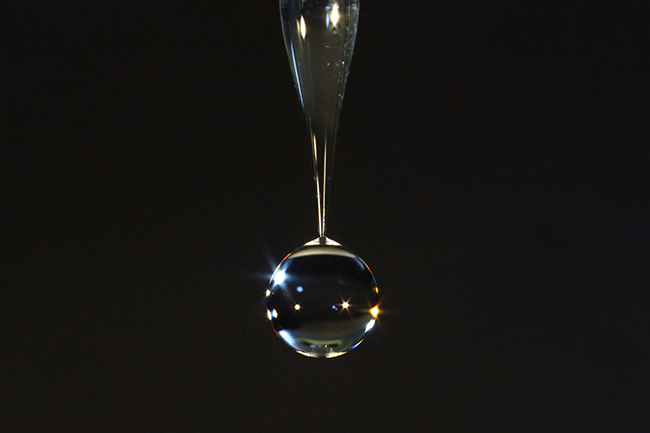Printing Microparticles for Drug Delivery

A startup emerging from Jennifer Lewis' lab intends to commercialize a technology platform that can produce microdroplets of highly viscous fluids, with applications in drug formulation and delivery. (Image courtesy of the Lewis Lab.)
Droplet-based printing of soft materials has exciting applications in biotech, electronics, and beyond. Researchers in Jennifer Lewis’ lab, with support from the Blavatnik Biomedical Accelerator, have developed a novel microparticle production technology that harnesses an acoustophoretic field to precisely dispense microdroplets from highly viscous fluids with droplet volumes ranging from sub-nL to uL. Importantly, this process doesn’t require high temperatures or shear stress, enabling the encapsulation and protection of cargo such as therapeutic molecules and stem cells. Acoustica Bio, a startup emerging from the Lewis Lab, intends to commercialize this technology by partnering with pharma companies to reformulate intravenous (IV) therapies into subcutaneous therapies (SC). The reformulation of dilute IV drug solutions into concentrated solutions suitable for SC injection is typically hampered by high viscosity, low solubility, aggregation, and poor stability. Using acoustophoretic printing, the company aims to encapsulate high molecular weight therapeutic molecules or biologics at high concentrations within hydrogel microparticles. Concentrated microparticle solutions can be formulated for subcutaneous drug delivery to improve patient care.

A startup emerging from Jennifer Lewis' lab intends to commercialize a technology platform that can produce microdroplets of highly viscous fluids, with applications in drug formulation and delivery. (Image courtesy of the Lewis Lab.)
Droplet-based printing of soft materials has exciting applications in biotech, electronics, and beyond. Researchers in Jennifer Lewis’ lab, with support from the Blavatnik Biomedical Accelerator, have developed a novel microparticle production technology that harnesses an acoustophoretic field to precisely dispense microdroplets from highly viscous fluids with droplet volumes ranging from sub-nL to uL. Importantly, this process doesn’t require high temperatures or shear stress, enabling the encapsulation and protection of cargo such as therapeutic molecules and stem cells. Acoustica Bio, a startup emerging from the Lewis Lab, intends to commercialize this technology by partnering with pharma companies to reformulate intravenous (IV) therapies into subcutaneous therapies (SC). The reformulation of dilute IV drug solutions into concentrated solutions suitable for SC injection is typically hampered by high viscosity, low solubility, aggregation, and poor stability. Using acoustophoretic printing, the company aims to encapsulate high molecular weight therapeutic molecules or biologics at high concentrations within hydrogel microparticles. Concentrated microparticle solutions can be formulated for subcutaneous drug delivery to improve patient care.

